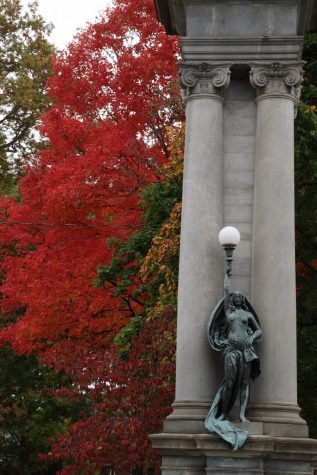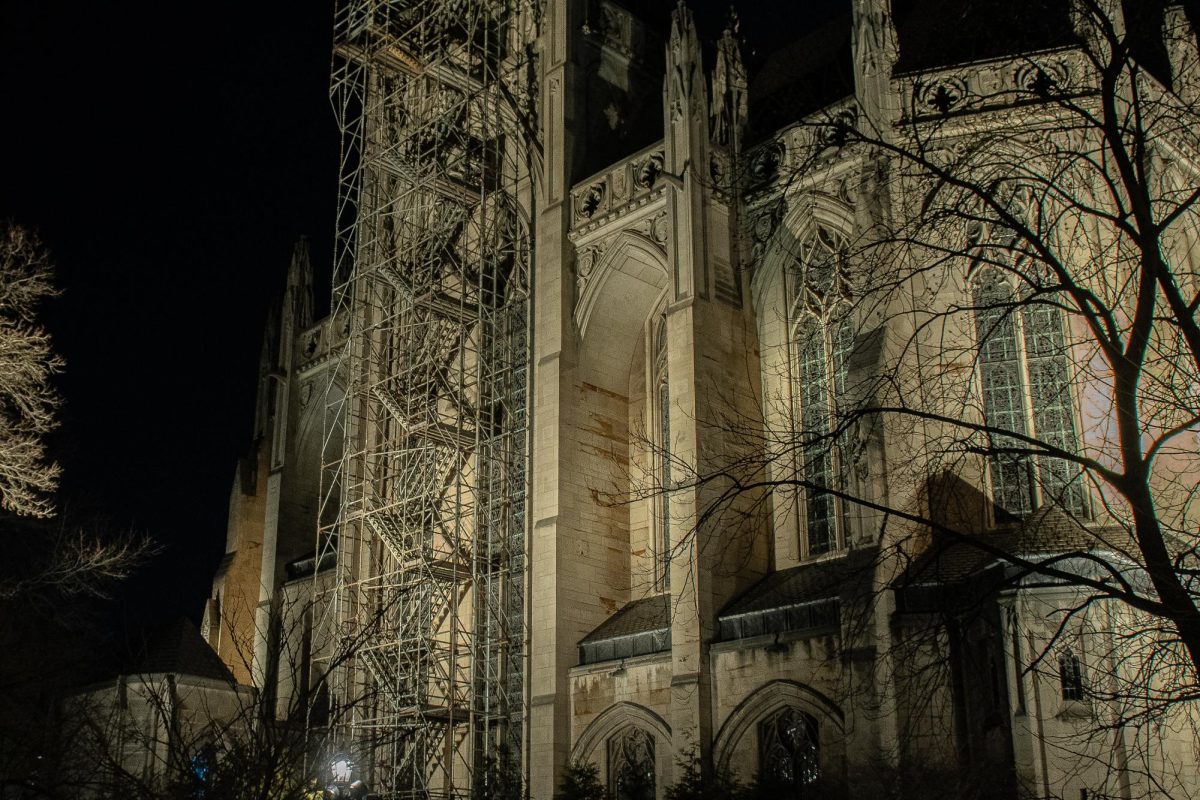Exploring Pittsburgh’s Parks | Highland Park
October 22, 2020
Between the neighborhood of the same name and the Allegheny River, Highland Park lies a little further afield for the average Pitt student than the other parks we’ve visited. It is certainly worth the lengthy jaunt up Highland Avenue from the Eastside though — or the quick 71A or B ride in from Oakland.
The park’s entrance along Highland Avenue can only rightly be described as “stately,” with its twin pillars surmounted and flanked by classical sculptures, immediately preceding a garden and fountain. Behind it, a double staircase climbs up to the reservoir — but more about that in a minute.

On the first trip I took to explore Highland this autumn, the air was cool and crisp, and while many of the trees were either still green or just beginning to change with the season, a maple behind one of the right entrance pillars had turned a rich scarlet. The vibrance of the leaves stood out all the more beside the white pillars and the dappled black and blue-green of the disrobed neoclassical lantern-bearers.
Turning to the right myself, I set off along the Reservoir Drive path, ignoring the stairs to the reservoir and following my usual inclination to seek the “backwaters” of a park before returning to its more frequented areas.
While Reservoir Drive and its associated path circles the hilltop, there are a number of trails that turn off down the hills into the many groves of trees that surround the sides of the main hill.
Taking a gravel connecting trail off Reservoir Drive, one soon arrives at the park’s recreational hub, with volleyball nets, empty pools — closed first for the pandemic, now, more normally, for the winter — and a fenced off-lead area where dogs can run in relative freedom, tongues lolling and tails wagging.
Behind the dog park a trail descends into the Hawthorne Grove. The trail was unmarked as far as I could tell, but is referred to as the “Overlook Trail” on one online trail guide, indicating its initial course along a ridge towards the Allegheny River which is unfortunately obscured from view by the trees.
The Overlook Trail is a good trail for mountain biking (made treacherous by the carpet of fallen leaves), and still better for a brisk hike, winding its way down the hillside under the cover of the trees. It eventually emerges in the wetlands area that lies as a buffer between the woods and Washington Boulevard. From there, one can take the Mayor’s Trail to the right, and will soon arrive at Highland’s outdoor velodrome — an angled track on which high-speed cyclists train.
Halfway along the bike track, the Elm Trail starts off to the right, back into the woods and up the steep hillside. While it’s not the longest trail, less than a fourth of a mile in length, it is one of the steepest and most difficult that I have encountered in any of our city’s parks, sharply ascending by way of boulder stairways and precarious dirt switchbacks, before at last reaching the Elm Grove beside Lake Drive.
One can then follow Lake Drive’s comparatively gentle slope back up the hill, a pleasant respite following the rigor of the Elm Trail climb. The drive passes by one of the park’s shelters — the day I visited a small gathering was being held beneath it, and the silver-blue smoke of a cookout rose into the cloudless sky.
Eventually you’ll arrive at Carnegie Lake, which, following the precedent of Panther Hollow’s “lake,” really feels more like a large pond to me — but a classic pond it is.
Rafts of water lilies float in its center, but you can easily approach them via the cross-shaped pier which traverses the pond. Groups of ducks paddle about its edge, expecting scraps of bread from passing families — many of whom happily oblige them, whatever the park policies regarding feeding wildlife might be. The begging waterfowl find less luck with the weekend fishermen who sit at the edge of the pond, stoically indifferent.
Satisfied with my exploration of the lower slopes of the hill, I returned to the Reservoir Drive loop by way of another connecting trail. I soon arrived before a brick and slate building adjoining the reservoir, whose elegance belies its mundane but crucial function — a Pittsburgh Water & Sewer Authority microfiltration plant.
Climbing the staircase beside the filtration plant, one finally arrives at the reservoir, and the walkway that completely circles its lip. The man-made reservoir — which is actually only one of the two in Highland Park (the second however, is covered and inaccessible to the general public) — dwarfs the pond I encountered earlier.
Ducks gather in the reservoir as well, floating near the edge of the vast pool, which supplies water to several of the city’s neighborhoods, including parts of Oakland. This fact was very present in my thoughts as I looked over the deep gray-blue of the waters, waters drawn up from the Allegheny River to be filtered and sent off through myriad pipes — and perhaps drunk by myself or one of my Oakland-dwelling friends later that day.
From the reservoir loop, it’s only a short walk over to Mount Bigelow, which marks the highest point in Highland Park. It would be a fine place to look out over the surrounding hills and neighborhoods if not for the surrounding trees which obscure them from sight.
Continuing counter-clockwise around the reservoir, I came to the last stop on my ramble. Returning to near the front of the park, I turned off the Reservoir Drive path, cutting downhill into the Memorial Grove, which lies just above the Pittsburgh Zoo.
Acorns spread like seashells on a beach cracked and scattered beneath my bike’s tires as I descended the slope, rolling to a stop before the reason for the grove’s name — a monument and gravestone to Alexander Negley, and his wife, Mary Ann Burkstresser. The memorial tells the brief outline of Negley’s life as an immigrant from Germany who fought in the American Revolution, and settled in the region of what was to become Highland Park over 120 years later.
While a lifelong resident of Pittsburgh, I admittedly know all too little about its history, so I was surprised when I saw the third name on the monument — that of its patron. The memorial was commissioned by Alexander’s granddaughter, Sarah Jane Negley Mellon, the matriarch of the powerful Mellon family and the mother of R.B. Mellon, the namesake of our previously explored Pittsburgh park.
Like its reservoir which provides water to the city’s inhabitants, Highland Park, it seems, is one of Pittsburgh’s wellsprings of names, influence and history.



